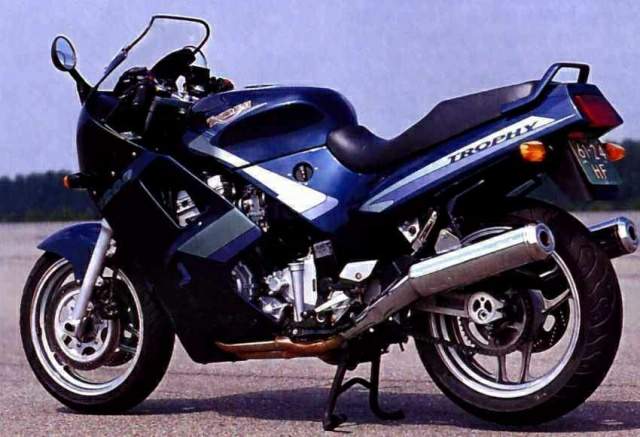
|
|
|
|
|
|
Classic Bikes
Custom Bikes
Individual
Racing Bikes AJP
AJS
Aprilia
Ariel
Avinton / Wakan
Bajaj
Benelli
Beta
Bimota
BMW
Brough Superior
BRP Cam-Am
BSA
Buell / EBR
Bultaco
Cagiva
Campagna
CCM
CF Moto
Combat Motors
Derbi
Deus
Ducati
Excelsior
GASGAS
Ghezzi Brian
Gilera
GIMA
Harley Davidson
Hero
Highland
Honda
Horex
Husaberg
Husqvarna
Hyosung
Indian
Jawa
Kawasaki
KTM
KYMCO
Laverda
Lazareth
Magni
Maico
Mash
Matchless
Mondial
Moto Guzzi
Moto Morini
MV Agusta
MZ / MuZ
NCR
Norton
NSU
Paton
Peugeot
Piaggio
Revival Cycles
Roland Sands
Royal Enfield
Sachs
Sherco
Sunbeam
Suzuki
SWM
SYM
Triumph
TVS
Ural
Velocette
Vespa
Victory
Vincent
VOR
Voxan
Vyrus
Walt Siegl
Walz
Wrenchmonkees
Wunderlich
XTR / Radical
Yamaha
Zero
Video
Technical
Complete Manufacturer List
|
Triumph Trophy 1200
The first of revitalized Triumph's modular superbikes caused a sensation when it was released in 1991. A big, four-cylinder machine designed to deliver both performance and comfort, the Trophy 1200 was fast, smooth, stable, sophisticated - a match in almost every department for the very best sports-tourers on the roads. So impressive was the British firm's debut model that it could have been built by one of the Japanese giants. Instead it had been developed from scratch by the team led by John Bloor, the multi-millionaire builder who had bought bankrupt Triumph from the liquidator in 1983. Bloor then spent eight years secretly building an impressive new factory at Hinckley, not far from Triumph's old Meriden base, and planning a range of modular machines.
Three- and four-cylinder engine layouts used alternative crankshafts to produce four different motors. These powered six initial models, the biggest of which was the four-cylinder Trophy.
Apart from its modular construction, which was unique in the bike world, the Trophy's 1180cc engine was conventional. The watercooled in-line four contained 16 valves, worked by twin overhead camshafts, and produced a very respectable maximum of 125bhp at 9000rpm. More impressive still was its crisp carburetion and outstanding supply of midrange torque, which made riding the big Triumph delightfully easy and relaxing.
Instant acceleration was available everywhere, from below 2000rpm to the redline at 9500rpm. Simply winding back the throttle sent the Trophy hurtling forward with a breathtaking mixture of power, tractability and smoothness.
There were no power steps, just a steady stream of irrepressible torque that sent the Triumph surging towards a top-speed of just over 150mph and made its excellent six-speed gearbox almost redundant. Better still, efficient twin balancer shafts ensured that vibration was minimal at all engine speeds.
Triumph's modular approach was also employed in the chassis, notably the frame, shared by all six models and based around a single large-diameter steel spine that incorporated the engine as a stressed member.
The frame held 43mm forks and a vertical rear monoshock, both from Japanese specialists Kayaba. Brakes were also made in Japan, by Nissin. Twin-piston front calipers squeezed a pair of 296mm discs up front, giving braking that was adequate - but no more - in conjunction with the single rear disc.
Although the spine frame design appeared dated in comparison with the latest alloy twin-beam constructions, the Trophy handled very well. In a straight line it was totally stable at all speeds, and barely gave a twitch even in bumpy high-speed curves. Chassis geometry was fairly conservative, and at 5291bs the bike was no lightweight. But the Triumph's steering was neutral, suspension was good and the bike could be hustled along a-twisty road at a very respectable rate.
The Trophy's efficient full fairing, large fuel tank and comfortable seat were also well designed. Along with the Triumph's impressive strength and reliability, they combined to create a superb sportstourer that was competitive with long-standing Japanese favorites such as Kawasaki's ZZ-R1100 and Yamaha's FJ1200. If the Trophy had a fault, it was simply that its four-cylinder engine layout and conservative styling were unexceptional.
Few riders complained after they'd tried the Trophy 1200, which became a long-standing success for the British firm. In subsequent years it was refined with features including uprated brakes, a lower seat, improved finish and a clock in the dashboard. All helped to make the first new-generation Triumph an even more competent all-round superbike than ever.

|
|
|
Any corrections or more information on these motorcycles will be kindly appreciated. |